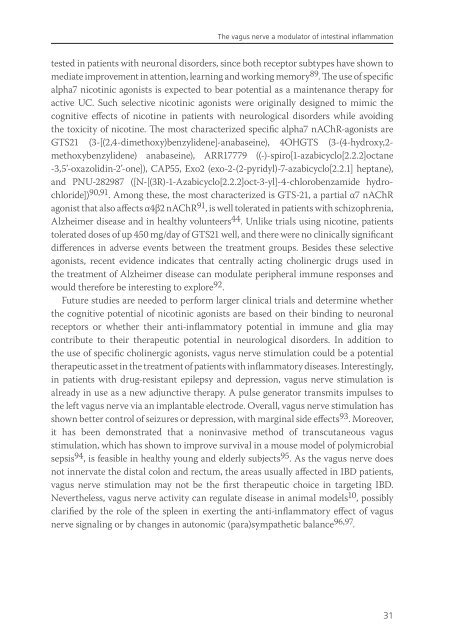The vagus nerve as a modulator of intestinal inflammation - TI Pharma
The vagus nerve as a modulator of intestinal inflammation - TI Pharma
The vagus nerve as a modulator of intestinal inflammation - TI Pharma
Create successful ePaper yourself
Turn your PDF publications into a flip-book with our unique Google optimized e-Paper software.
<strong>The</strong> <strong>vagus</strong> <strong>nerve</strong> a <strong>modulator</strong> <strong>of</strong> <strong>intestinal</strong> <strong>inflammation</strong><br />
tested in patients with neuronal disorders, since both receptor subtypes have shown to<br />
mediate improvement in attention, learning and working memory 89 . <strong>The</strong> use <strong>of</strong> specific<br />
alpha7 nicotinic agonists is expected to bear potential <strong>as</strong> a maintenance therapy for<br />
active UC. Such selective nicotinic agonists were originally designed to mimic the<br />
cognitive effects <strong>of</strong> nicotine in patients with neurological disorders while avoiding<br />
the toxicity <strong>of</strong> nicotine. <strong>The</strong> most characterized specific alpha7 nAChR-agonists are<br />
GTS21 (3-[(2,4-dimethoxy)benzylidene]-anab<strong>as</strong>eine), 4OHGTS (3-(4-hydroxy,2methoxybenzylidene)<br />
anab<strong>as</strong>eine), ARR17779 ((-)-spiro[1-azabicyclo[2.2.2]octane<br />
-3,5’-oxazolidin-2’-one]), CAP55, Exo2 (exo-2-(2-pyridyl)-7-azabicyclo[2.2.1] heptane),<br />
and PNU-282987 ([N-[(3R)-1-Azabicyclo[2.2.2]oct-3-yl]-4-chlorobenzamide hydrochloride])<br />
90,91 . Among these, the most characterized is GTS-21, a partial α7 nAChR<br />
agonist that also affects α4β2 nAChR 91 , is well tolerated in patients with schizophrenia,<br />
Alzheimer dise<strong>as</strong>e and in healthy volunteers 44 . Unlike trials using nicotine, patients<br />
tolerated doses <strong>of</strong> up 450 mg/day <strong>of</strong> GTS21 well, and there were no clinically significant<br />
differences in adverse events between the treatment groups. Besides these selective<br />
agonists, recent evidence indicates that centrally acting cholinergic drugs used in<br />
the treatment <strong>of</strong> Alzheimer dise<strong>as</strong>e can modulate peripheral immune responses and<br />
would therefore be interesting to explore 92 .<br />
Future studies are needed to perform larger clinical trials and determine whether<br />
the cognitive potential <strong>of</strong> nicotinic agonists are b<strong>as</strong>ed on their binding to neuronal<br />
receptors or whether their anti-inflammatory potential in immune and glia may<br />
contribute to their therapeutic potential in neurological disorders. In addition to<br />
the use <strong>of</strong> specific cholinergic agonists, <strong>vagus</strong> <strong>nerve</strong> stimulation could be a potential<br />
therapeutic <strong>as</strong>set in the treatment <strong>of</strong> patients with inflammatory dise<strong>as</strong>es. Interestingly,<br />
in patients with drug-resistant epilepsy and depression, <strong>vagus</strong> <strong>nerve</strong> stimulation is<br />
already in use <strong>as</strong> a new adjunctive therapy. A pulse generator transmits impulses to<br />
the left <strong>vagus</strong> <strong>nerve</strong> via an implantable electrode. Overall, <strong>vagus</strong> <strong>nerve</strong> stimulation h<strong>as</strong><br />
shown better control <strong>of</strong> seizures or depression, with marginal side effects 93 . Moreover,<br />
it h<strong>as</strong> been demonstrated that a noninv<strong>as</strong>ive method <strong>of</strong> transcutaneous <strong>vagus</strong><br />
stimulation, which h<strong>as</strong> shown to improve survival in a mouse model <strong>of</strong> polymicrobial<br />
sepsis 94 , is fe<strong>as</strong>ible in healthy young and elderly subjects 95 . As the <strong>vagus</strong> <strong>nerve</strong> does<br />
not innervate the distal colon and rectum, the are<strong>as</strong> usually affected in IBD patients,<br />
<strong>vagus</strong> <strong>nerve</strong> stimulation may not be the first therapeutic choice in targeting IBD.<br />
Nevertheless, <strong>vagus</strong> <strong>nerve</strong> activity can regulate dise<strong>as</strong>e in animal models 10 , possibly<br />
clarified by the role <strong>of</strong> the spleen in exerting the anti-inflammatory effect <strong>of</strong> <strong>vagus</strong><br />
<strong>nerve</strong> signaling or by changes in autonomic (para)sympathetic balance 96,97 .<br />
31













